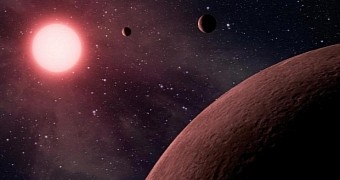Theories concerning the formation of planets outside the Solar System say that large, gassy planets not different from our Jupiter can only form at a considerable distance from their parent star.
The problem is that, having spent years trying to make head and tail of the anatomy of the universe that surrounds us, scientists found that many Jupiter-sized planets sit oddly close to their parent star.
For quite a while, how and why these planets ended up being stunningly close to their star was nothing short of a puzzle. However, astronomers with the University of California believed to have finally solved this mystery.
It's their companions that are to blame
Writing in the journal Science, specialists Rebekah Dawson and Eugene Chiang explain that, having run a series of computer simulations, they found that other planets not far from the Jupiter-like giants are to blame for the latter's odd position in space.
More precisely, the researchers say that, according to evidence at hand, it is possible for another planet to change the cosmic address of a hot or warm Jupiter-like exoplanet by pulling it closer to its parent star, Phys Org informs.
This means that, as postulated by planetary formation theories forwarded thus far, planets like our Jupiter do in fact form quite far from their parent stars and only move closer to them under the influence of a massive companion.
A perfect storm of circumstances
In their paper, astronomers Rebekah Dawson and Eugene Chiang detail that, as part of this investigation, they used computers to put together several systems whose makeup included a Jupiter-like planet and another very big celestial body.
They then ran about 1,000 simulations for each of the systems, covering about 200 million years of cosmic turmoil. It was thus discovered that, as long as the Jupiter-like planet and its massive companion were not in the same plane, the latter could alter the location of the former.
Specifically, the scientists claim that, in order for one giant planet to exert a gravitational influence strong enough to push a Jupiter-sized planet closer to its parent star, the two celestial bodies must be located in different planes with angles ranging from 35 to 65 degrees.
Admittedly, other forces and variables are at play as well and, in the end, it all boils down to a perfect storm of circumstances, but, as stressed by Rebekah Dawson and Eugene Chiang, it's not sci-fi to say a planet similar to Jupiter was brought closer to its star by a companion.

 14 DAY TRIAL //
14 DAY TRIAL //